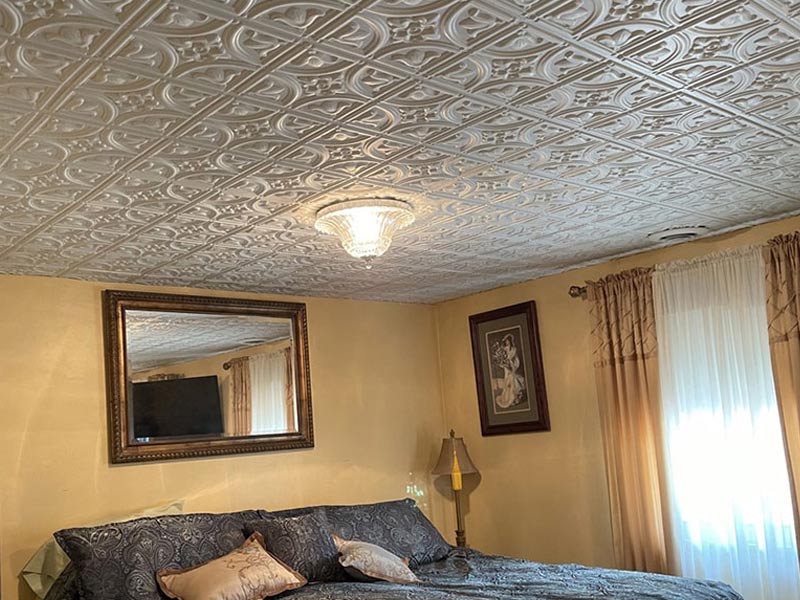Drop-In Ceiling Tiles Vs Nail-Up Ceiling Tiles Vs Glue-Up Ceiling Tiles
Written by Milan Jara on 28th Jul 2021

When it comes to ceiling tiles, there are different methods on how to install them. How you install a ceiling tile depends on the material of tile and the type of ceiling you’re trying to fit it on to. This guide will compare the difference between a drop-in tile, a nail-up tile, and a glue-up tile, and discuss the pros and cons for each one.
Drop-In Ceiling Tiles
Drop ceiling tiles tend to be used when installing the tiles into drop ceilings. Usually, these tiles hide building infrastructure like plumbing and wiring. You can also use them to keep these systems easily accessible, and they are ideal for hiding damaged ceilings.
Pros of drop-in ceiling tiles are:
- Easy Access: As mentioned, when you have installed drop ceiling tiles, they should be giving you easy access.
- Repairs are Straightforward: If there is ever water that has damaged an area, then drop ceilings are easily fixable.
- Aesthetically Pleasing: The look of a drop ceiling is, or can be, spectacular. With a range of different patterns and textures, including everything from tin tiles to styrofoam, there are plenty of designs to choose from.
- Lighting: Installing lighting fixtures and changing the lighting is incredibly straightforward with a drop ceiling.
- Sound Insulation: These ceiling tiles are an effective way to insulate the sound in a room. If you’re looking to block sound, installing drop-in ceiling tiles is a great way to do that.
The cons of having drop-in ceiling tiles are:
- The look can Split Opinion: This may not be as much of a problem as it used to be, but there are people out there who simply prefer the look of a smoother ceiling.
- Loss of Height: If you’re going to use a batch of drop-in ceiling tiles for a dropped ceiling, then you need to expect a surface that will be 4-6 inches below the floor joists in order to install them. So, if your ceiling already feels low and the room feels a little small already, then this can be an issue for you.
- Installation: The planning side to installing drop-in ceiling tiles is easy, but the process of installing them isn’t a fast one.
- Cost: Drop-in ceiling tiles do not come cheap, so if you’re on a budget, then you will have to calculate the costs accordingly.

Nail-Up Ceiling Tiles
Nail-up ceiling tiles come in different designs that are available in tin, aluminum, and copper. Regardless of which material you opt for, they all possess the ability to ignite popular design styles, including modern, colonial, Victorian, and others. Ultimately, nail-up ceiling tiles have an overlapping nail rail of a quarter of an inch, allowing you to make applications onto wood and with furring strips in the easiest of ways.
Pros of nail-up ceiling tiles include:
- Easy Installation: When it comes to DIY projects, it doesn’t get much easier than having to nail up your new decorative ceiling tiles in place.
- Reflective Qualities: These tiles may have reflective qualities that you may not find with other ceiling tile options on the market. Therefore, if you’re looking for a way for your ceiling to stand out, installing a set of nail-up ceiling tiles may be the way to go.
Cons of nail-up ceiling tiles include:
- Weight: Nail-up ceiling tiles are larger than drop-in ceiling tiles and many other ceiling tile types. Because of this, you will need to begin with a strong ceiling as the base before the installation, making sure that the tiles do not slip.
Glue-Up Ceiling Tiles

Glue-up ceiling tiles mount directly to a sound installation surface using adhesive. The tiles butt to one another after installation, and self-adhering strips cover the joints between the tiles.
When considering glue-on ceiling tiles to complete a room or project, think about the decision from every angle and compare the details of other tile options. With traditional tiles, the glue doesn’t need runners to be nailed or stapled to.
Pros of glue-up ceiling tiles include:
- Cutting the Border Tiles: These tiles can fit tightly against the wall, as well as having the ability to handle floor traffic on overhead ceilings.
- Sound Insulation: Glue-up ceiling tiles can help with sound deadening, quieting the noise spread through the upstairs or even to the room below it.
The cons of having glue-up ceiling tiles include:
- Removing the tiles: If you’re at a point where you want to change the style or decor of a room, and your ceiling contains glue-up ceiling tiles, then the process of removing them may not be that straightforward. Typically, the tiles break when you attempt to pull them from the ceiling, and if you’re the one removing them, then you may need a putty knife and a little elbow grease to scrape away the remnants.
- Installation: With this process, it can be extremely messy. Drop cloths are necessary and should prevent the glue from dripping as they are applied.
In conclusion, choosing the right set of tiles depends on the type of ceiling you’re trying to renovate and the abilities you have as a DIYer. If you do not hold that much experience, then attempting a dropped ceiling may be a lot more difficult than the other two sets of tiles.
On the other hand, if you fit a ceiling that contains plenty of loose wires and pipes – somewhere like a basement – then opting for drop-in ceiling tiles is undoubtedly necessary.
All three types of ceiling tiles have their advantages and disadvantages, and when it comes to choosing which set is best for your ceiling, it is down to you to weigh up these pros and cons, check to see what kind of project is needed and seek advice if you are still unsure.